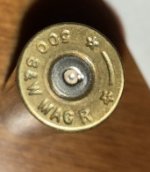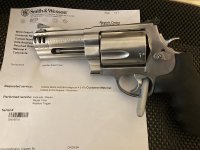First off that off center hit is NOT the source of ignition, it's way too off center to trigger that primer. The ignition source is that dead center hit. That second hit is caused by the hammer rebounding during recoil and the cause is because you have the trigger pulled all the way back during recoil. Note, when the trigger is released the hammer block is position to prevent the hammer from contacting the firing pin. Problem is that I don't think it's humanly possible to release the trigger during recoil. Bottomline this is rather typical when shooting full power Magnums.
Note the sequence is as follows, the hammer falls and is stopped by the firing pin, they the gun recoils and carries the hammer backwards, next you control the recoil and bring the gun back on target firmly, then the hammer returns forward due to the mainspring. So, the next question becomes what is kicking the cylinder counterclockwise. The culprit hear is the cylinder stop getting kicked out of the notch during recoil. A problem that IIRC was corrected on the 44 Magnums as part of the "endurance package". I would expect that the 500 Magnum would also have this package but there is a possibility that the factory dropped the ball and used an incorrect and weaker cylinder stop spring when assembling your revolver.
Finally if you are doing that super slow motion carry up test or dragging a thumb while testing for carry up YOU ARE DOING IT WRONG. This methodology is all internet hogwash. The S&W revolver is a Combat Revolver and has clearances that insure that the gun will function properly after being dropped a pool of mud. As a result they will rely on Inertia to carry the cylinder into lock to small extent. Yeah they can be tuned to perfection for this but the downside of doing this will result in a cylinder stop with a tendency to jam if stop and notch aren't perfectly clean.
The final test is the cylinder movement when it's locked by both the cylinder stop and the hand. With an unloaded revolver pull the hammer back to full lock, secure it with your thumb and pull the trigger back completely. Hold that trigger back and lower the hammer slowly. Then test how much movement there is to the cylinder. This movement should be tiny, small enough that you only feel it and don't see any movement visually. That is the ideal for lockup. However if you can see just a hint of movement that is tolerable, what you do not want to see is any movement approaching the thickness of a thin piece of paper.
After reading you initial post I'm thinking that someone prior to you has been poking into your cylinder stop spring and I suspect that your's is weak. As you know it's an easy part to replace and I find it surprising it wasn't replaced when S&W worked on your gun. Because that should be a near automatic response for the issue you have reported.


